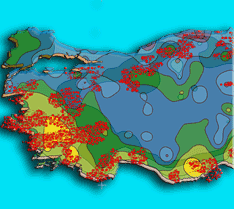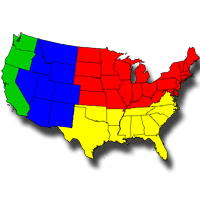The spatial interpolation and multi-criteria decision analysis (MCDA) capabilities of geographic information systems have the potential to create new approaches to forest management. In this study of heterogeneously structured stand maps, the potential use of the regularized spline with tension (RST) interpolation method and of ELECTRE TRI MCDA was investigated. For each species and diameter class, one map of the predicted volume per ha was produced with the RST method. The map used data from a total of 1050 circular sample plots. By repeating the same process for the eight species occurring in the study area, 31 volume maps were produced. The accuracy of these prediction maps was calculated at the pixel (20 x 20 m) level and at the area level (per ha). An accuracy of greater than or equal to 97% was achieved at the pixel level, whereas a minimum accuracy of 86% was achieved for the area-based calculations. In addition, these 31 volume maps were compared with the management report results obtained from the government institute responsible for defining management plans. These comparisons were performed for the total volume of all species with volume ratios greater than 1%. The comparisons showed 21, 14, 4, and 2 % accuracies for Calabrian pine, Oriental beech, black pine and oak species, respectively. Following interpolation, these 31 maps were geo-computed, and a volume-based stand map was produced. The 890 different mixture variations resulting from combinations of the volume of species composition and the stand diameter class in these maps were classified according to expert knowledge. In this classification process, ELECTRE TRI MCDA was used to benefit from the capabilities provided by geographic information systems. Finally, ELECTRE TRI was used to reduce the 890 different mixture combinations to 70 stand type classes.
Keywords
, , ,
Citation
Destan S, Yilmaz O, Sahin A (2013). Making objective forest stand maps of mixed managed forest with spatial interpolation and multi-criteria decision analysis. iForest 6: 268-277. - doi: 10.3832/ifor0099-006
Academic Editor
Agostino Ferrara
Paper history
Received: May 18, 2012
Accepted: Mar 18, 2013
First online: Jul 01, 2013
Publication Date: Oct 01, 2013
Publication Time: 3.50 months
© SISEF - The Italian Society of Silviculture and Forest Ecology 2013
Open Access
This article is distributed under the terms of the Creative Commons Attribution-Non Commercial 4.0 International (https://creativecommons.org/licenses/by-nc/4.0/), which permits unrestricted use, distribution, and reproduction in any medium, provided you give appropriate credit to the original author(s) and the source, provide a link to the Creative Commons license, and indicate if changes were made.

Breakdown by View Type
(Waiting for server response...)
Article Usage
Total Article Views: 58873
(from publication date up to now)
Breakdown by View Type
HTML Page Views: 48356
Abstract Page Views: 3719
PDF Downloads: 5208
Citation/Reference Downloads: 24
XML Downloads: 1566
Web Metrics
Days since publication: 4555
Overall contacts: 58873
Avg. contacts per week: 90.47
Article Citations
Article citations are based on data periodically collected from the Clarivate Web of Science web site
(last update: Mar 2025)
Total number of cites (since 2013): 9
Average cites per year: 0.69
Publication Metrics
by Dimensions ©
Articles citing this article
List of the papers citing this article based on CrossRef Cited-by.
(1)
Akhavan R, Amiri GhZ, Zobeiri M (2010)Spatial variability of forest growing stock using geostatistics in the Caspian region of Iran. Caspian Journal Environmental Sciences 8: 43-53.
Online |
Gscholar
(2)
Aktas S, Yilmaz OY (2011)Producing of stand draft maps with spatial prediction methods. Journal of the Faculty of Forestry, Istanbul University, Turkey 62(2):131-146.
Gscholar
(3)
Anonymous (2011a)Forest Management Plan Forestry Asar 2010-2019. Regional Directorate of Forests in Çanakkale, General Directorate of Forests, Ministry of Environment and Forests, Ankara, Turkey.
Gscholar
(4)
Anonymous (2011b)Forest Management Plan Forestry Yenice 2010-2019. Regional Directorate of Forests in Çanakkale, General Directorate of Forests, Ministry of Environment and Forests, Ankara, Turkey.
Gscholar
(5)
Aurbi P, Debouzie D (2000)Geostatistical estimation variance for the spatial mean in two dimensional systematic sampling. Ecology 81: 543-553.
CrossRef |
Gscholar
(6)
Balteiro LD, Romero C (2008)Making forestry decisions with multiple criteria: a review and an assessment. Forest Ecology and Management 255: 3222-3241.
CrossRef |
Gscholar
(7)
Burrough PA (2001)GIS and geostatistics: essential partners for spatial analysis. Environmental and Ecological Statistics 8: 361-377.
CrossRef |
Gscholar
(8)
Dubayah RO, Drake JB (2000)Lidar remote sensing for forestry applications. Journal of Forestry 98 (6): 44-52.
Gscholar
(9)
Dubayah R, Knox R, Hofton M, Blair JB, Drake J (2000)Land surface characterization using Lidar remote sensing. In: “Spatial information for land use management” (Hill MJ, Aspinall RJ eds). International Publishers Direct, Singapore, pp. 25-38.
Gscholar
(10)
D’Orazio M (2003)Estimating the variance of the sample mean in two-dimensional systematic sampling. Journal of Agricultural, Biological and Environmental Statistics 8: 280-295.
CrossRef |
Gscholar
(11)
Efron B, Gong G (1983)A leisurely look at the bootstrap, the jackknife, and cross-validation. The American Statistician 37: 36-48.
CrossRef |
Gscholar
(12)
Estornell J, Ruiz LA, Velázquez-Martí B, Fernández-Sarría A (2011)Estimation of shrub biomass by airborne LiDAR data in small forest stands. Forest Ecology and Management 262: 1697-1703.
CrossRef |
Gscholar
(13)
Feng Y, Tang S, Li Z (2006)Application of improved sequential indicator simulation to spatial distribution of forest types. Forest Ecology and Management 222: 391-398.
CrossRef |
Gscholar
(14)
Flores LA, Martinez L I, Ferrer CM (2003)Systematic sample design for the estimation of spatial means. Environmetrics 14: 45-61.
CrossRef |
Gscholar
(15)
Forest Management Regulation Handbook (2008)General Directorate of Forests, Ministry of Environment and Forests in Turkey. Official Gazette of the Republic of Turkey No: 26778, pp. 18.
Gscholar
(16)
General Directorate of Forests (2006)Forests in Turkey. Ministry of Environment and Forests in Turkey, Ankara, pp. 160.
Gscholar
(17)
Graf RF, Mathys L, Bollmann K (2009)Habitat assessment for forest dwelling species using LiDAR remote sensing: Capercaillie in the Alps. Forest Ecology and Management 257: 160-167.
CrossRef |
Gscholar
(18)
GRASS Development Team (2011)Geographic resources analysis support system (GRASS) Software. Open Source Geospatial Foundation Project.
Online |
Gscholar
(19)
Guibal D (1973)Estimating oukoumés Gabon. Internal Memo #333, Center Morphology, Mathematics, Fontainbleau, France.
Gscholar
(20)
Gunnarsson F, Holm S, Holmgren P, Thuresson T (1998)On the potential of kriging for forest management planning. Scandinavian Journal of Forest Research 13: 237-245.
CrossRef |
Gscholar
(21)
Haywood A (2011)Semi-automating the stand delineation process in mapping natural eucalypt forests. Australian Forestry 74 (1): 13-22.
CrossRef |
Gscholar
(22)
Heikkinen J (2006)Assement of uncertainty in spatially systematic sampling. Forest inventory, methodology and applications. Managing Forest Ecosystems 10 (1): 155-176.
CrossRef |
Gscholar
(23)
Hengl T (2007)A practical guide to geostatistical mapping of environmental variables. EUR 22904 EN Scientific and Technical Research Series no. 143, Office for Official Publications of the European Communities, Luxemburg, Belgium.
Gscholar
(24)
Hofierka J, Parajka J, Mitasova H, Mitas L (2002)Multivariate interpolation of precipitation using regularized spline with tension. Transactions in GIS 6: 135-150.
CrossRef |
Gscholar
(25)
Holmgren P, Thuresson T (1997)Applying objectively estimated and spatially continuous forest parameters in tactical planning to obtain dynamic treatment units. Forest Science 43: 317-326.
Gscholar
(26)
Huth A, Drechsler M, Köhler P (2005)Using multi-criteria decision analysis and a forest growth model to assess impacts of tree harvesting in Dipterocarp lowland rain forests. Forest Ecology and Management 207: 215-232.
CrossRef |
Gscholar
(27)
Höck BK, Payn TW, Shirley JW (1993)Using a geographic information system and geostatistics to estimate site index of
Pinus radiata for Kangaroo Forest, New Zealand. N. Z. J. Forrest. Science 23: 264-277.
Gscholar
(28)
Jost A (1993)Geostatistical analysis of sampling error for systematic sampling. Ph.D. thesis, University of Freiburg,Breisgau, Germany, pp. 113. [In German]
Gscholar
(29)
Kangas J, Kangas A (2005)Multiple criteria decision support in forest management-the approach, methods applied, and experiences gained. Forest Ecology and Management 207: 133-143.
CrossRef |
Gscholar
(30)
Kangas A, Kangas J, Pykäläinen J (2001)Outranking methods as tools in strategic natural resources planning. Silva Fennica 35 (2): 215-227.
Online |
Gscholar
(31)
Khadka C, Vacik H (2012)Use of multi-criteria analysis (MCA) for supporting community forest management. iForest 5: 60-71.
CrossRef |
Gscholar
(32)
Kirschbaum MU, Watt MS (2011)Use of a process-based model to describe spatial variation in Pinus radiata productivity in New Zealand. Forest Ecology and Management 262: 1008-1019.
CrossRef |
Gscholar
(33)
Kovacs JM, Liu Y, Zhang C, Flores-Verdugo F, de-Santiago FF (2011)A field based statistical approach for validating a remotely sensed mangrove forest classification scheme. Wetlands Ecology and Management 19: 409-421.
CrossRef |
Gscholar
(34)
Köhl M, Magnussen S, Marchetti M (2006)Sampling methods, remote sensing and GIS multiresource forest inventory. In: “Remote Sensing” (chapt. 4). Springer Verlag, Heidelberg, Germany.
Gscholar
(35)
Jayanath A, Gamini H (2009)A critical review of multi-criteria decision making methods with special reference to forest management and planning. Ecological Economics 68(10): 2535-2548.
Gscholar
(36)
Lappi J, Kangas A (2006)Use of additional information. In: “Forest inventory - Methodology and Application” (chapt. 7). Springer, The Hague,the Netherlands. pp. 107-117.
Gscholar
(37)
Li J, Heap AD (2008)A review of spatial interpolation methods for environmental ecientists. No. Record 2008/23, Geoscience Australia, Canberra, Australia.
Gscholar
(38)
Li J, Heap AD (2011)A review of comparative studies of spatial interpolation methods in environmental sciences: Performance and impact factors. Ecological Informatics 6: 228-241.
CrossRef |
Gscholar
(39)
Lovell JL, Jupp DJB, Newnham GJ, Coops NC, Culvenor DS (2005)Simulation study for finding optimal Lidar acquisition parameters for forest height retrieval. Forest Ecology and Management 214: 398-412.
CrossRef |
Gscholar
(40)
Magnussen S, Næsset E, Wulder MA (2009)Efficient multiresolution spatial predictions for large data arrays. Remote Sensing of Environment 109: 451-463.
CrossRef |
Gscholar
(41)
Mandallaz D (1991)A unified approach to sampling theory for forest inventory based on infinite population and super population models. Chair of forest management and planning, Swiss Federal Institute of Technology, Zurich, Switzerlands.
CrossRef |
Gscholar
(42)
Mendoza GA, Martins H (2006)Multi-criteria decision analysis in natural resource management: a critical review of methods and new modeling paradigms. Ecology and Forest Management 230: 1-206.
CrossRef |
Gscholar
(43)
Mitas L, Mitasova H (1999)Spatial interpolation. In: “Geographical information systems: principles, techniques, management and applications” (Longley P, Goodchild MF, Maguire DJ, Rhind DW eds). GeoInformation International, Wiley, pp. 481-492.
Gscholar
(44)
Mitasova H, Mitas L, Brown WM, Gerdes DP, Kosinovski I, Baker T (1995)Modeling spatially and temporally distributed phenomena: new methods and tools for GRASS GIS. International Journal of Geographical Information Systems 9: 433.
CrossRef |
Gscholar
(45)
Mitasova H, Mitas L, Harmon RS (2005)Simultaneous spline approximation and topographic analysis for lidar elevation data in open-source GIS. Geoscience and Remote Sensing Letters IEEE 2: 375-379.
CrossRef |
Gscholar
(46)
Montes F, Alicia F, Ledo A (2010)Incorporating environmental and geographical information in forest data analysis: a new fitting approach for universal kriging. Canadian Journal of Forest Research 40 (9): 1852-1861.
CrossRef |
Gscholar
(47)
Nanos N, Calama R, Montero G, Gil L (2004)Geostatistical prediction of height/diameter models. Forest Ecology and Management 195: 221-235.
CrossRef |
Gscholar
(48)
Neteler M, Mitasova H (2008)Open Source GIS: a GRASS GIS approach. Kluwer. Academic Publishers/Springer, Boston, USA. pp.406.
Gscholar
(49)
Neteler M, Bowman MH, Landa M, Metz M (2012)GRASS GIS: a multi-purpose open source GIS. Environmental Modelling and Software 31: 124-130.
CrossRef |
Gscholar
(50)
Palmer DJ, Höck BK, Kimberley MO, Watt MS, Lowe DJ, Payn TW (2009)Comparison of spatial prediction techniques for developing Pinus radiata productivity surfaces across New Zealand. Forest Ecology and Management 258: 2046-2055.
CrossRef |
Gscholar
(51)
Perez-Soba M, Edwards D, Tabbush P (2006)Assessing the impacts of EU policies on sustainable forest management: the sensor approach. In: EFI Scientific Seminar “The role of Forestry in Integrated Environmental Assessment”. , The Netherlands.
Gscholar
(52)
Quantum GIS Development Team (2012)Quantum GIS geographic information system. Open Source Geospatial Foundation Project.
Online |
Gscholar
(53)
Schaffer C (1993)Selecting a classification method by cross-validation. Machine Learning 13 (1): 135-143.
CrossRef |
Gscholar
(54)
Shao J (1993)Linear model selection by cross-validation. Journal of the American Statistical Association 88: 486-494.
CrossRef |
Gscholar
(55)
Sherman M (1996)Variance estimation for statistics computed from spatial lattice data. Journal of the Royal Statistical Society 58: 509-523.
Online |
Gscholar
(56)
Smart LS, Swenson JJ, Christensen NL, Sexton JO (2012)Three-dimensional characterization of pine forest type and red-cockaded woodpecker habitat by small-footprint, discrete-return Lidar. Forest Ecology and Management 281:100-110.
CrossRef |
Gscholar
(57)
Sobrie O (2010)Integration of ELECTRE TRI in a GIS coupling with a XMCDA web service for inference. In: Proceedings of the 73 Meeting of the European Working Group “Multiple Criteria Decision Aiding”. 8 Decision Deck Workshop. University of Mons (Belgium) 13 April 2011.
Online |
Gscholar
(58)
Tang D, Bian F (2009)Forest site evaluation based on GIS and kriging. In: ICISE ’09 Proceedings of the “2009 First IEE International Conference on Information Science and Engineering”. Nanjing, Jiangsu China, December 26-December 28, IEEE Computer Society Washington, DC, USA, pp. 2063-2067.
Gscholar
(59)
Tattoni C, Ciolli M, Ferretti F, Cantiani MG (2010)Monitoring spatial and temporal pattern of Paneveggio forest (northern Italy) from 1859 to 2006. iForest 3 (1): 72-80.
CrossRef |
Gscholar
(60)
Tattoni C, Ciolli M, Ferretti F (2011)The fate of priority areas for conservation in protected areas: a fine-scale Markov chain approach. Environmental Management 47: 263-278.
CrossRef |
Gscholar
(61)
Tattoni C, Rizzolli F, Pedrini P (2012)Can LiDAR data improve bird habitat suitability models? Ecological Modelling 245: 103-110.
CrossRef |
Gscholar
(62)
Tuominen S, Fish S, Poso S (2003)Combining remote sensing, data from earlier inventories and geostatistical interpolation in multi-source forest inventory. Canadian Journal of Forest Research 33: 624- 634.
CrossRef |
Gscholar
(63)
Viana H, Aranha J, Lopes D, Cohen WB (2012)Estimation of crown biomass of
Pinus pinaster stands and shrubland above-ground biomass using forest inventory data, remotely sensed imagery and spatial prediction models. Ecological Modelling 226: 22-35.
CrossRef |
Gscholar
(64)
Wallerman J, Joyce S, Vencatasawmy CP, Olsson H (2002)Prediction of forest stem volume using kriging adapted to detected edges. Canadian Journal of Forest Research 32: 509-518.
CrossRef |
Gscholar
(65)
Wilsey CB, Joshua J, Lawler JJ, David A, Cimprich DA (2012)Performance of habitat suitability models for the endangered black-capped vireo built with remotely-sensed data. Remote Sensing of Environment 119:35-42.
CrossRef |
Gscholar
(66)
Zawadzki J, Cieszewski CJ, Zasada M, Lowe RC (2005)Applying geostatistics for investigations of forest ecosystems using remote sensing imagery. Silva Fennica 39 (4): 599-617.
Online |
Gscholar


















